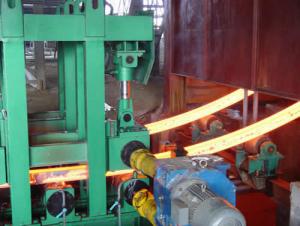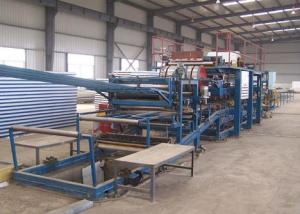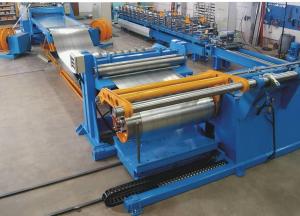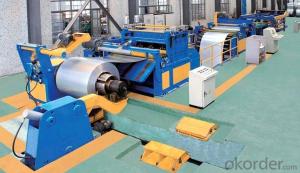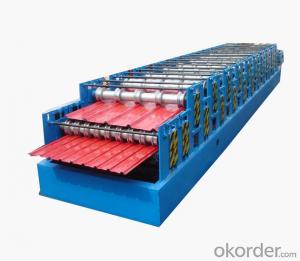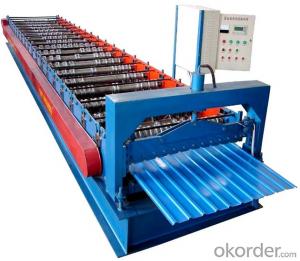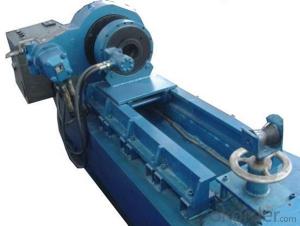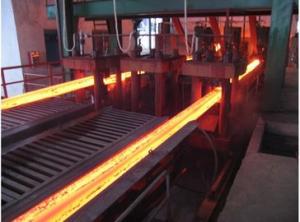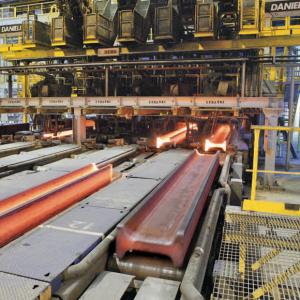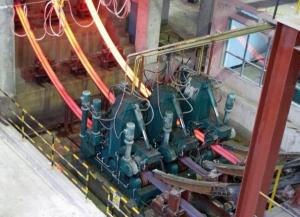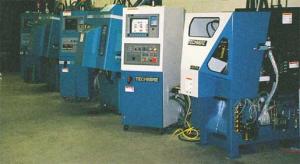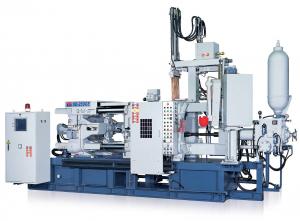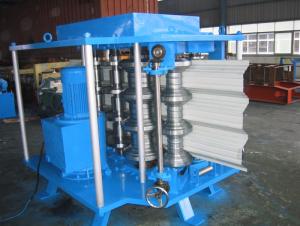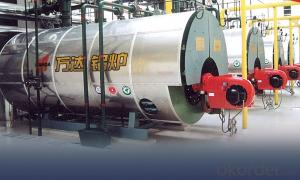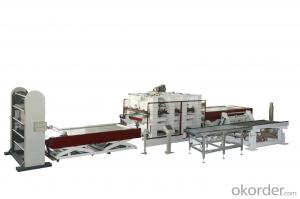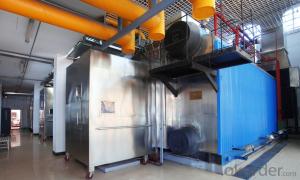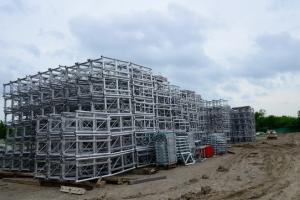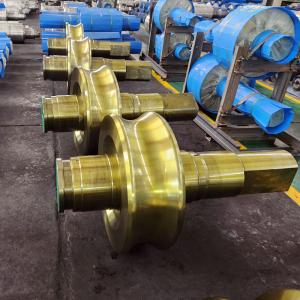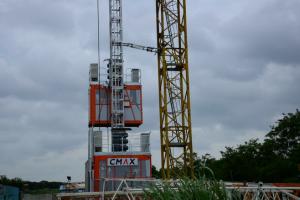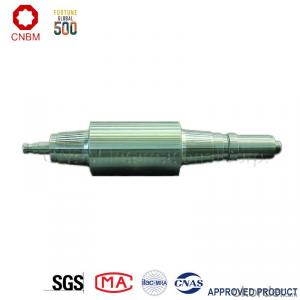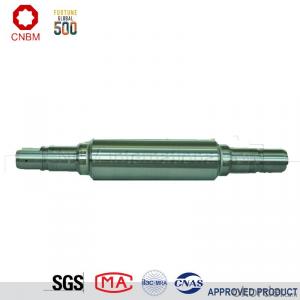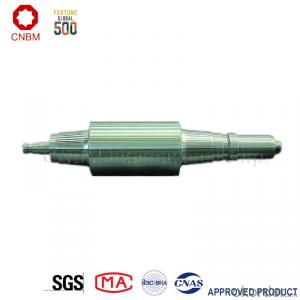Steel Continuous Casting Machine
- Loading Port:
- China Main Port
- Payment Terms:
- TT or LC
- Min Order Qty:
- 1 Set set
- Supply Capability:
- 30 Sets Per Year set/month
OKorder Service Pledge
Quality Product, Order Online Tracking, Timely Delivery
OKorder Financial Service
Credit Rating, Credit Services, Credit Purchasing
You Might Also Like
Technology process:
1.Heat the EVA film
2.Cover the heated EVA film on the mould(can be made from wood or aluminum)
3.Spray a coating in a certain baume degree
4.Put on the empty blask
5.Sand-up the flask and vibrate to compaction
Packaging & Delivery
Packaging Details:containers
Delivery Detail:Complete one set of equipment needs for three months
- Q:What are the different types of machining processes used to refine castings made with metal casting machinery?
- There are several different types of machining processes that are commonly used to refine castings made with metal casting machinery. These processes are essential to achieve the desired final shape, dimensions, and surface finish of the casting. Some of the most common machining processes used in this context include: 1. Turning: This process involves rotating the casting on a lathe and removing material using a cutting tool. Turning is used to create cylindrical shapes, such as shafts or tubes, and to achieve precise dimensions. 2. Milling: Milling is a versatile machining process that involves cutting the casting using a rotating multi-point cutting tool. This process can be used to create various shapes, slots, and holes on the casting's surface. 3. Drilling: Drilling is the process of creating holes in a casting using a rotating drill bit. It is commonly used to create holes for fasteners, such as bolts or screws, or for other purposes like fluid flow passages. 4. Grinding: Grinding is a process that uses an abrasive wheel to remove material from the casting's surface. This process is used to achieve a smooth and precise surface finish or to remove any imperfections or excess material left from the casting process. 5. Boring: Boring is a machining process used to enlarge existing holes in the casting. It involves rotating a cutting tool with a single point, which removes material to increase the diameter of the hole. 6. Broaching: Broaching is a process that uses a specialized tool with multiple teeth to remove material in a linear motion. This process is often used to create keyways or splines on the surface of the casting. 7. Tapping: Tapping is a machining process used to create internal threads in a casting. It involves using a specialized cutting tool, called a tap, to cut threads into a pre-drilled hole. 8. Honing: Honing is a precision machining process that uses abrasive stones to improve the surface finish and dimensional accuracy of the casting. It is commonly used to create a smooth and uniform internal surface. These machining processes are typically performed after the casting has been cooled and solidified. They are essential for refining the casting and achieving the desired final product, ensuring that it meets the required specifications and quality standards.
- Q:What are the different types of surface finishing and coating methods used in metal casting machinery?
- There are several types of surface finishing and coating methods used in metal casting machinery. These include sandblasting, shot blasting, grinding, polishing, painting, electroplating, powder coating, and anodizing. Each method is used to achieve different surface properties and enhance the appearance, protection, or functionality of the metal castings.
- Q:Can metal casting machinery be used for recycling purposes?
- Yes, metal casting machinery can be used for recycling purposes. Metal casting machinery is commonly used in recycling facilities to process and transform scrap metal into new products. The machinery is capable of melting down various types of metal, such as iron, steel, aluminum, and copper, and then casting them into molds to create new parts or products. This process allows for the efficient and cost-effective recycling of metal, reducing the need for the extraction of new raw materials and minimizing waste. Additionally, metal casting machinery can also be used to separate different types of metals, ensuring that each metal is recycled properly and used in the appropriate applications. Overall, metal casting machinery plays a crucial role in the recycling industry, enabling the conversion of scrap metal into valuable resources while promoting sustainability and environmental conservation.
- Q:What are the different types of challenges and opportunities in the global metal casting machinery market?
- The growth and development of the global metal casting machinery market are shaped by various challenges and opportunities. One primary challenge in this market is the rising competition from low-cost alternatives like 3D printing and additive manufacturing. These technologies offer faster production times and lower costs, making them attractive for specific applications. To remain competitive in this evolving landscape, metal casting machinery manufacturers must continuously innovate and enhance their products. Another challenge is the environmental impact of metal casting processes. The industry faces pressure to reduce its carbon footprint and adopt more sustainable practices. This involves minimizing waste, reducing energy consumption, and exploring cleaner technologies. Manufacturers that provide environmentally friendly solutions will have a competitive edge. Moreover, the global metal casting machinery market is influenced by geopolitical factors, such as trade policies and tariffs. These factors create uncertainties and disrupt supply chains, making it difficult for manufacturers to plan and adjust their operations. Companies in this market must closely monitor geopolitical developments and have contingency plans to mitigate risks. Despite these challenges, there are several opportunities in the global metal casting machinery market. One significant opportunity is the increasing demand for lightweight materials in industries like automotive and aerospace. Manufacturers can capitalize on this trend by developing advanced casting techniques that enable the production of lightweight and high-strength components. Furthermore, the growing adoption of automation and robotics presents an opportunity to improve production efficiency and reduce labor costs. Integrating robotics into processes allows for higher precision, faster production times, and enhanced quality control. Additionally, the expanding industrialization in emerging economies creates a favorable market for metal casting machinery. As these economies continue to grow, the demand for metal cast components in sectors like construction, infrastructure, and energy is expected to rise. Manufacturers can tap into these markets by establishing strategic partnerships and expanding distribution networks. In conclusion, the global metal casting machinery market faces challenges like competition from alternative technologies, environmental concerns, and geopolitical uncertainties. However, there are also opportunities arising from the demand for lightweight materials, automation, and the growth of emerging economies. By addressing these challenges and capitalizing on the opportunities, metal casting machinery manufacturers can position themselves for long-term success in the global market.
- Q:Can metal casting machinery be used for producing castings with high dimensional accuracy?
- Yes, metal casting machinery can be used for producing castings with high dimensional accuracy. Metal casting processes, such as investment casting and precision casting, utilize advanced machinery and techniques to achieve precise and accurate dimensional measurements. In investment casting, also known as lost-wax casting, a wax pattern is created and then coated with a ceramic shell. Once the ceramic shell is hardened, the wax is melted out, leaving behind a cavity in the shape of the desired casting. Molten metal is then poured into the cavity, filling the space and taking the shape of the original wax pattern. This process allows for detailed and intricate designs to be accurately replicated. Precision casting, on the other hand, uses a mold made of a durable material, such as steel or aluminum, to create the desired casting shape. The mold is created using Computer-Aided Design (CAD) software and CNC machining techniques, ensuring precise and accurate measurements. Molten metal is then poured into the mold, resulting in a casting with high dimensional accuracy. Furthermore, advancements in technology have led to the development of sophisticated machinery and equipment in metal casting processes. Computer Numerical Control (CNC) machines are commonly used to ensure precise and repeatable movements during the manufacturing process. These machines are capable of accurately controlling the speed, position, and movement of tools, resulting in castings with high dimensional accuracy. Additionally, quality control measures, such as the use of Coordinate Measuring Machines (CMMs) and laser scanning devices, are employed to verify the dimensional accuracy of castings. These devices can measure and compare the dimensions of the casting with the original design specifications, allowing for adjustments to be made if necessary. Overall, with the combination of advanced machinery, precision casting techniques, and quality control measures, metal casting machinery can indeed be used to produce castings with high dimensional accuracy.
- Q:How do you expand your business and reach new customers in international markets?
- Expanding a business and reaching new customers in international markets requires a strategic approach and careful planning. Here are some key steps that can help in achieving this goal: 1. Market Research: Conduct thorough market research to identify potential international markets that align with your business goals and target audience. Consider factors such as market size, competition, cultural differences, and economic stability. 2. Develop a Market Entry Strategy: Based on the market research, develop a comprehensive market entry strategy. This strategy should outline the specific approach to be taken in each target market, including the mode of entry (e.g., exporting, licensing, joint venture, or direct investment) and the marketing tactics to be used. 3. Localize Your Offering: Adapt your products or services to suit the needs and preferences of the target market. This may involve making changes to the packaging, branding, pricing, or even modifying the product itself to align with local regulations, tastes, or cultural norms. 4. Build Relationships: Establish strong relationships with local partners, distributors, or agents who have a deep understanding of the target market. These partnerships can help navigate local regulations, overcome cultural barriers, and provide valuable market insights. 5. Effective Marketing and Promotion: Implement a targeted marketing and promotion strategy to create awareness and generate interest in your products or services. Utilize various channels, such as digital marketing, social media, trade shows, and local advertising, to reach the target audience effectively. 6. Provide Excellent Customer Support: Ensure you have a robust customer support system in place to address the needs of your international customers. This can include multilingual customer service teams, localized websites, and clear communication channels to resolve any issues promptly. 7. Continuous Monitoring and Adaptation: Regularly monitor the performance of your international expansion efforts and adapt your strategies accordingly. Stay updated on market trends, competitor activities, and customer feedback to identify areas for improvement and make necessary adjustments. 8. Compliance and Legal Considerations: Understand and comply with the legal and regulatory requirements of each target market. This includes understanding local tax laws, intellectual property protection, import/export regulations, and any other relevant legal obligations. 9. Leverage Technology: Utilize technology to streamline operations and facilitate international business expansion. This can include e-commerce platforms, cloud-based systems, and online payment gateways to enhance efficiency and ease of doing business across borders. 10. Invest in Talent Development: Develop a diverse and multicultural team that can effectively communicate and understand the nuances of international markets. Provide training and development programs to enhance employees' cross-cultural communication skills and global business acumen. Expanding in international markets requires patience, persistence, and a commitment to understanding and adapting to different cultures and business practices. By following these steps, businesses can broaden their customer base, increase revenue, and achieve long-term success in international markets.
- Q:Can metal casting machinery be used for investment casting of cobalt-based alloys?
- Metal casting machinery is capable of being used for investment casting of cobalt-based alloys. Investment casting, also referred to as lost-wax casting, is a flexible method that can produce intricate and complex shapes in various materials, including cobalt-based alloys. To manufacture top-quality castings of cobalt-based alloys through the investment casting process, metal casting machinery like furnaces, wax injection systems, and ceramic shell coating equipment can be employed. These machines enable precise control of temperature, pressure, and other factors to guarantee the desired casting properties and dimensional accuracy. However, it is worth noting that cobalt-based alloys possess unique characteristics, which may call for specific considerations during the investment casting process, such as the utilization of specialized refractory materials or adjustments to the casting parameters. Therefore, seeking guidance from experts or manufacturers experienced in casting cobalt-based alloys is recommended to ensure optimal outcomes.
- Q:What are the common molding materials used in centrifugal casting with metal casting machinery?
- The common molding materials used in centrifugal casting with metal casting machinery are sand, plaster, and ceramic.
- Q:What are the different types of mold coatings used in metal casting machinery?
- There are several types of mold coatings commonly used in metal casting machinery, including graphite, zircon, alumina, and silica-based coatings. These coatings help improve the surface finish and reduce defects on the castings, as well as enhance the mold's thermal properties and prevent metal sticking. Each type of coating possesses unique characteristics and is chosen based on the specific requirements of the casting process.
- Q:What are the common heat treatment processes used in metal casting machinery?
- The common heat treatment processes used in metal casting machinery are annealing, normalizing, quenching, tempering, and case hardening.
Our professions include metallurgical technology, equipment and automation. We can provide the best solutions to the production process, design & manufacture of equipment and electrical automation regarding various industries in domestic and foreign districts with exquisite technology and fine quality service. We can provide all-around services to customers from development & design to the provision, installation and running of products.Strong technical strength, advanced equipment manufacturing technology, fine quality professional talents, and perfect service systems all bring about reliability, relaxation, convenience and delight to the cooperation with customers from beginning to end.
1. Manufacturer Overview |
|
|---|---|
| Location | Jiangsu,China (Mainland) |
| Year Established | 2000 |
| Annual Output Value | |
| Main Markets | South America Eastern Europe Southeast Asia Africa Mid East South Asia Domestic Market |
| Company Certifications | |
2. Manufacturer Certificates |
|
|---|---|
| a) Certification Name | |
| Range | |
| Reference | |
| Validity Period | |
3. Manufacturer Capability |
|
|---|---|
| a)Trade Capacity | |
| Nearest Port | SHANGHAI |
| Export Percentage | 21% - 30% |
| No.of Employees in Trade Department | 3-5 People |
| Language Spoken: | English, Chinese |
| b)Factory Information | |
| Factory Size: | |
| No. of Production Lines | |
| Contract Manufacturing | |
| Product Price Range | |
Send your message to us
Steel Continuous Casting Machine
- Loading Port:
- China Main Port
- Payment Terms:
- TT or LC
- Min Order Qty:
- 1 Set set
- Supply Capability:
- 30 Sets Per Year set/month
OKorder Service Pledge
Quality Product, Order Online Tracking, Timely Delivery
OKorder Financial Service
Credit Rating, Credit Services, Credit Purchasing
Similar products
New products
Hot products
Hot Searches
Related keywords
